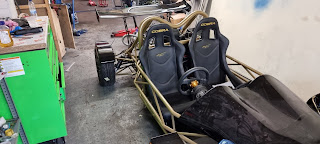With a few more weeks in the workshop under the belt, progress has been rapido.
The car looks like it should work. The wings and wheel arches are in place, seats are in and most of the engine ancillaries are fitted.
Apologies for no pics from the front, the car is close to a wall, so I couldn't get everything in shot, so you'll have to make do with ass shots.
So lets talk about the dashboard. For simplicity and to get it complete quicker, I'm using the dash from the bike. This may change in the future, but lets get a few laps on the clock first. Those with eagle eyes will notice that the dash is mounted upside down. This was due to some advice from an someone who builds race cars for a living... Basically, if it was mounted the correct way up then the rev counter would be way over to the left rather than in the drivers eye line. Mounting it this way, puts it in the peripheral vision especially when hitting the higher revs.
Here's a shot of the engine 'bay'. The throttle bodies and airbox are now in place amongst other stuff. I thought that the airbox would be uglier and stick up more, but as it is, I can live with it. There are alternatives, but they're not cheap, so it's another thing on the list to consider later. There's still more to be done back here, with the main bits being the starter motor and the gear shifter.
This is as close to a front view as it gets. The seats are in, and fit (phew). The drivers seat does need to go back a bit once the fuel tank is moved to the passenger side. This view does give a good view of the rear wing which is a monster! Lets hope it's better than the Countach rear wing which actually created lift.
I can't finish this post without giving a special shout out to Len of Wildmoor Motorsport. Len agreed to help me finish off this project along with Callum who works with Len. Sadly, Len passed away earlier this month which is a true loss to motorsport. Len was a top bloke and had a wealth of knowledge and experience and will be sadly missed. RIP Len.






